Clouds in the Aviation Environment
- Clouds are visible indications of atmospheric processes which provide clues on frontal activity and general weather patterns
- While there is no requirement for a pilot to be able to identify every cloud type by name and classification, basic knowledge can mean the difference between a comfortable flight, and a dangerous one
- Much like a river, as you approach, you can get a feel for currents and stability by how it looks - Clouds are no different
- Clouds form based on four factors
- Clouds are grouped by families according to their shape, behavior, and altitudes:
- Low Clouds (Stratus)
- Middle Clouds (Alto)
- High Clouds (Cirrus)
- Clouds with Vertical Development:
- Others
- For flight planning purposes prevailing visibility and clouds heights are reported by meteorological sources
- Calculating cloud heights provides an accurate estimation of what to expect or correlation of other information
- Solid clouds usually indicate frontal movement, while broken clouds suggest turbulence
- Rain clouds contain the prefix or suffix nimbus
- Nimbus: heavy or violent precipitation
- Cumulonimbus: thunderstorm
- Warmer air is more humid because it can hold more moisture
- To saturate the air, you must evaporate or cool it
- Think you've got a solid understanding of clouds in the aviation environment? Don't miss the clouds in the environment quiz below, and topic summary
Cloud Formation:
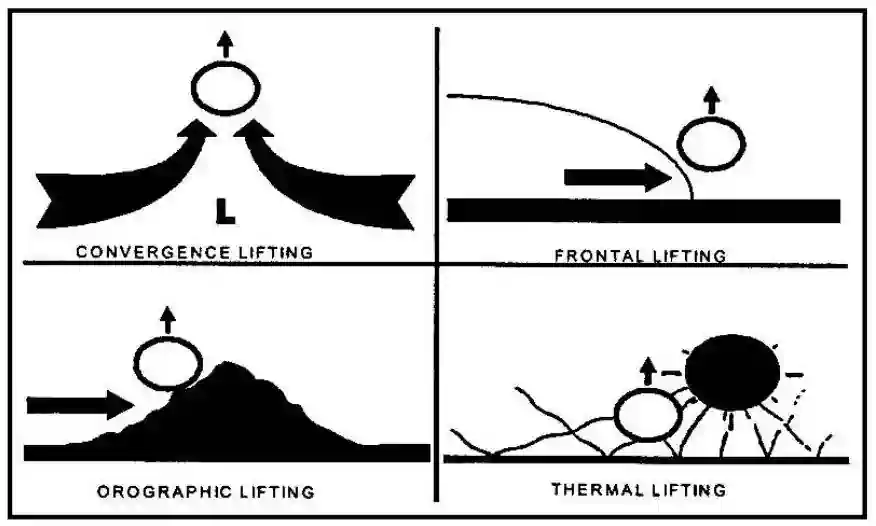
- Formation requires moisture to be lifted, where it condenses at its dew-point into visual moisture
- The acronym COFT labels convergence, orographic, frontal, and thermal lifting mechanisms [ Figure 1 ]
- Convergence Lifting
- Orographic Lifting
- Frontal Lifting
- Thermal Lifting
-
-
Convergence Lifting:
- Convergence lifting occurs when two air masses converge on one another
Orographic Lifting:
- Orographic lifting occurs when air is forced up the side of a mountain until it cools and condenses
Frontal Lifting:
- Frontal lifting is caused by the movement of dissemilar air masses
- Cold Front: cold air encounters warmer air, pushing the warm air up, causing lifting
- Warm Front: warm air encounters cooler air where it will rise above it, causing lifting
Thermal Lifting:
- Thermal, also called convective lifting, occurs when the ground is heated, causing the warmer air to rise
Low Clouds:
-
- Low clouds are those which extend from the surface up to about 6,500' [ Figure 2 ]
- Contain water, but sometimes may contain super-cooled water (icing hazard)
Stratus Clouds:
- Stratus clouds are layered
- Stratus clouds form in stable air near the surface due to cooling from below
- Stratus clouds form when moist stable air lifts up sloping terrain or when warm rain evaporates as it falls through the cool air
- Restrict visibility
Nimbostratus Clouds:
- Cause widespread areas of rain or snow
- Thick
Stratocumulus Clouds:
- Stratocumulus clouds are white puffy clouds that form as stable air lifts
- Often form as a stratus layer breaks up or as cumulus clouds spread out
- Generally lack enough moisture to cause rain
-
Middle Clouds:
- Middle clouds range from 6,500' to ~25,000' [ Figure 2 ]
- Composed of water crystals, ice crystals, or super-cooled water
- Middle clouds may contain turbulence and potential severe icing
Altostratus Clouds:
- Flat, dense clouds that cover a wide area
- Minimal turbulence
Altocumulus Clouds:
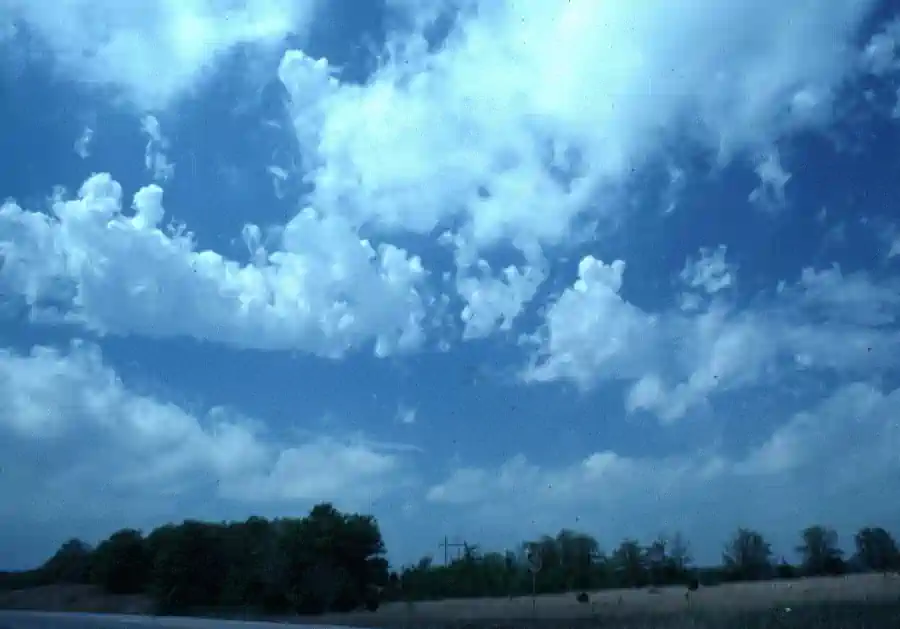
- Form when altostratus clouds start to break up [ Figure 3 ]
- Light turbulence
High Clouds:
- High clouds range from 20,000' to ~50,000', much higher than most general aviation operations [ Figure 2 ]
- Even if not operating within high clouds, they can still provide indications of the atmosphere
- White or light gray color composed mainly of ice crystals
- Seldom pose a serious turbulence or icing hazard
Cirrus Clouds:
Cirrostratus Clouds:
- Form long bands or sheets
- Moisture content is low and poses no icing hazard
Cirrocumulus Clouds:
- Look like cotton
- May produce light turbulence
Clouds With Vertical Development:
Very turbulent and unstable although typically fluffy in appearance giving you the false sense of "fair weather cumulus"
Cumulus Clouds:
- Form in convective currents resulting from the heating of the Earth's surface
- Flat bottoms with dome-shaped tops
- Widely spaced cumulus clouds are called fair-weather cumulus
- Fair-weather cumulus indicate some turbulence, but little icing or precipitation
Towering Cumulus Clouds:
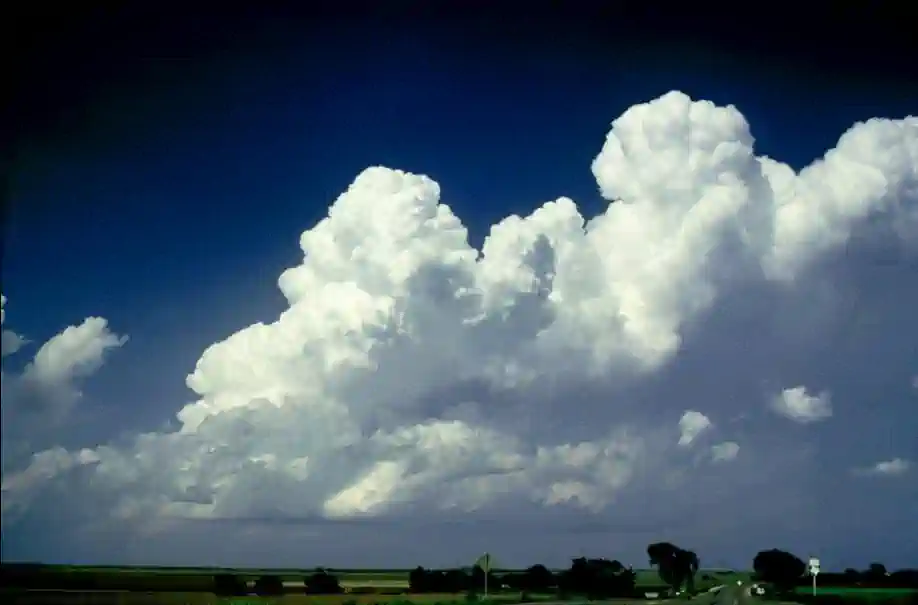
- Towering Cumulus clouds form from deep areas of unstable air, which can produce moderate to heavy turbulence with icing conditions [ Figure 4 ]
- Often form prior and eventually result in thunderstorms
Cumulonimbus Clouds:
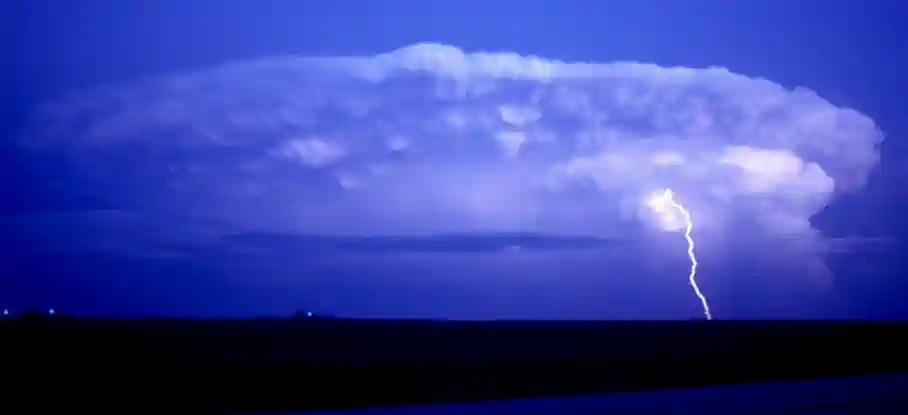
- More commonly called thunderstorms [ Figure 5 ]
- Form in unstable air with large amounts of moisture
- Very hazardous to flying
Other Clouds:
Lenticular Clouds:
- Lenticular clouds form on the leeward side of mountains [ Figure 6 ]
Cap Clouds:
Rotor Clouds:
- Rotor clouds are typically associated with turbulence [ Figure 6 ]
- They are indicitive of a local rolling wind phenomenon
- Just as important, however, is their presence alerts pilots to the possibility of extreme updrafts followed by extreme downdrafts, in rapid succession
Roll and Wall Clouds:

- Occur in severe and fast-moving thunderstorms
Reporting Prevailing Visibility:
- Aviation Routine Weather Reports (METARs) declare surface (horizontal) visibility in terms of statute miles and increments thereof; e.g., 1/16, 1/8, 16, 1/4, 16, 8, 2, 5/8, 3/4, 7/8, 1, 1 1/8, etc. (Visibility reported by an unaugmented automated site is reported differently than in a manual report, i.e., Automated Surface Observation System/Automated Weather Observation System) (ASOS/AWOS): 0, 1/16, 1/8, 1/4, 1 1/2, 1 3/4, 2, 1 3/4, 1, 1 1/4, 1 1/4, 2, 2 1/2, 3, 4, 5, etc., AWOS: M1/4, 1/4, 1/2, 3/4, 1, 1 1/4, 1 1/2, 1 3/4, 2, 2 1/2, 3, 4, 5, etc.) The ability to see and identify preselected and prominent objects at a known distance from the usual point of observation determines visibility. Visibilities that are determined to be less than 7 miles identify the obscuring atmospheric condition; e.g., fog, haze, smoke, etc., or combinations thereof
- Prevailing visibility is the greatest visibility equaled or exceeded throughout at least one-half of the horizon circle, not necessarily contiguous. Segments of the horizon circle which may have significantly different visibility are reported in the remarks section of the weather report; i.e., "the southeastern quadrant of the horizon circle may be determined to be 2 miles in mist while the remaining quadrants are determined to be 3 miles in mist"
- When the prevailing visibility at the usual point of observation, or the tower level, is less than 4 miles, certificated tower personnel will take visibility observations in addition to those taken at the usual point of observation. The lower of these two values becomes the prevailing visibility for aircraft operations
Reporting of Cloud Heights/Bases:
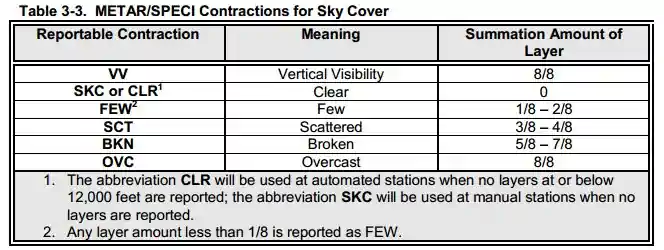
- Ceiling, by definition in the Code of Federal Regulations and as used in aviation weather reports and forecasts, is the height above ground (or water) level of the lowest layer of clouds or obscuring phenomenon that is reported as "broken," "overcast," or "obscuration" [ Figure 7 ]
- Example: a Terminal Aerodrome Forecast (TAF), which reads "BKN030" refers to the height above ground level indicates that the height is above mean sea level
- The Aeronautical Information Manual defines "broken," "overcast," and "obscuration"
- Pilots usually report height values above Mean Sea Level (MSL) since they determine heights by the altimeter
- This is taken into account when disseminating and otherwise applying information received from pilots
- "Ceiling" heights are always Above Ground Level (AGL)
- In reports disseminated as Pilot Reports (PIREPs), height references are given the same as received from pilots, that is, above MSL
- In area forecasts or inflight advisories, ceilings are denoted by the contraction "CIG" when used with sky cover symbols as in "LWRG TO CIG OVC005," or the contraction "AGL" after the forecast cloud height value
- When the cloud base is given in height above MSL, it is indicated by the contraction "MSL" or "ASL" following the height value
- The heights of clouds tops, freezing level, icing, and turbulence are always given in heights above ASL or MSL
- Advisory Circular (00-45) Aviation Weather Services, Sky Cover Contractions
Calculating Cloud Bases:
- To predict general cloud bases, you can perform a quick calculation:
Clouds in the Aviation Environment Knowledge Quiz:
Conclusion:
- Clouds are not just beautiful; they are also hazardous
- In areas with high humidity with present lifting criteria like Florida, clouds are clearly observed growing in real-time from the ground or the air
- CFI Notebook.net - Atmosphere
- CFI Notebook.net - Terminal Aerodrome Forecast (TAF)







